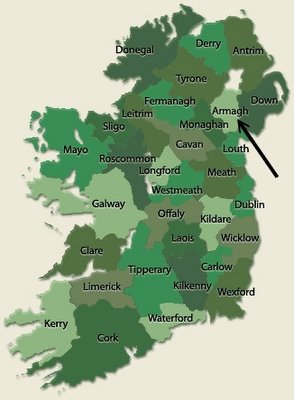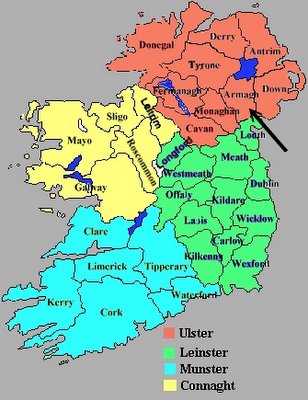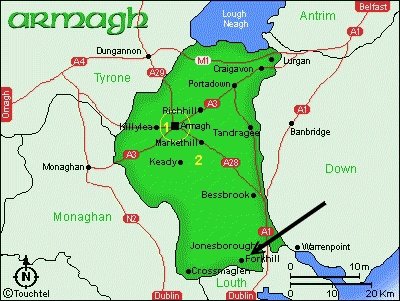Mullabawn is sometimes found spelled as Mullaghbawn. Forkill is also found spelled as Forkhill (with an 'h').

(arrow points to Armagh Co)

(arrow points to Armagh Co)

(arrow points to Forkill)
This southern part of Armagh Co in northern Ireland is sometimes referred to as the "Bandit country". It is a mix of Catholic and Protestant and has been a hotbed of IRA activity.
County Armagh (Contae Ard Mhacha in Irish) is a county in Ulster. It is the smallest of the six counties that form Northern Ireland. County Armagh is known as the Orchard County because the land is so fertile for apple-growing. Its main town is Armagh, in the middle of the county, although Lurgan and Portadown, in the north of the county, each have larger populations.
The county borders Lough Neagh to the north, County Down to the east, County Tyrone to the north-west, and counties Louth and Monaghan, both in the Republic of Ireland, to the south and south-west respectively.
The River Blackwater runs along the border with County Tyrone. The River Bann enters Lough Neagh in the north, flowing though the north-east of the county. Mountains in Armagh include Slieve Gullion, Carrigatuke and Camlough Mountain.
There are also a number of islands in the county's section of Lough Neagh: Coney Island, Coney Island Flat, Croaghan Flat, Derrywarragh Island, Padian, Phil Roe's Flat and the Shallow Flat.
Forkhill (Irish): from the Middle Irish oircél, probably meaning trough or valley. Cited as follows in translation: "we were in Forkill [in orcél], Slieve Fuad to the west of us, Slieve Gullion to the east". Attempts at explaining the origin of the name are invariabley based on later occurrences of the name in Irish documents and are wrong. Forkill, sometimes spelled wrongly Forkhill because of the steep inclines into the village from all sides, is a small village in south County Armagh, Northern Ireland, close to the border with County Louth in the Republic of Ireland. It is close to both Newry and Dundalk and lies in the foothills of Slieve Gullion beside Mullaghbawn. In the 2001 Census it had a population of 366 people. In 1837 it had 152 people. It lies within the Newry and Mourne District Council area.
Following is an excerpt of a posting I found on a Armagh mail list from Michael Reed regarding his trip to South Armagh in 1999. This indicates that Mullabrawn is "over the hill" from Forkill. It also gives an indication of the political environment of the area, the beauty of the countryside and the friendliness of the people.
". . . . with my wife and two young children drove to Newry and spent the night in a B&B north of town. The border was more or less invisible. During a drive through a housing estate on a hill above Newry, we saw political graffiti (IRA South Down Armagh Brigade) and we briefly crossed paths with three heavily armored Land Rovers (probably RUC, as "Crime-stoppers" was painted on the side).
They were impatient for us to get out of their way at a stop sign, honking at us to move along.
The landscape of South Armagh was very beautiful, with hilly farmland and pastures and small tidy villages. We drove the next morning through Camlough, Bessbrook, Carrickcrovaddy, Cullyhanna, Crossmaglen, Clonalig, Silverbridge, Mullabawn and Forkhill. Many of these very small villages had British or RUC military nstallations on nearby hills, and Crossmaglen has a base right next to the town square. There were frequent helicopter flights in and out of the bases and around the countryside. In Cullyhanna, we stopped at St. Patricks Church and cemetery and noted several family headstones. There is an IRA memorial in town, as there is in Crossmaglen. We then drove to Crossmaglen for lunch.
I should emphasize that at no time did we feel in personal danger. On the contrary, the occasional military presence seemed completely out of place in the bucolic countryside. That may not always have been the case, but it seemed that way to us. Crossmaglen was perhaps the friendliest village we visited in two weeks in Ireland. Shopkeepers and pub workers went out of their way to make us feel welcome and to offer genealogy advice to me. On their recommendation, we went to the church just outside of town (I couldn't find the name, but it's the large Catholic Church). We noted several McGeeney headstones. A woman in the cemetery directed me to the parish house and Father McGeough, the parish priest. although I hadn't even called in advance, he graciously sat down with me for 20 minutes on a Saturday evening to browse the parish baptismal and marriage records. We found pages of well organized records of McGeeneys, which is a very unusual surname, and I may have actually broken through a "brick wall" in locating my great-great-great grandfather's baptismal record.
For Forkhill parish records, Fr. McGeough directed me to Mullabawn, and St. Mary's Church. The cemetery again contained several family headstones, but the parish priest didn't really have time to sit down with me, and referred me to the diocese records in Armagh which have been mentioned on this list.
On the drive over the hill to Mullabawn, we got lost and took a tiny country road over the hill. We stopped several times to take pictures of the stunning landscape and wildflowers, including a wonderful view of Slieve Gullion, which dominates the countryside. A military helicopter, evidently wondering what on earth we were doing, hovered over us for a few minutesand then flew on. We also passed tourists having "pony treks" through the countryside.
From Mullabawn we drove out of Northern Ireland through Forkhill, and again we didn't even realize when we had passed over the border.
All in all, this was the most satisfying part of my journey to Ireland, mainly because of the personal connection. in addition, however, this was also some of the most beautiful landscape and some of the friendliest people I encountered. Although the military presence and political graffiti were out of place and disturbing (as if you were seeing them in West Virginia), the area appeared very safe for tourists and I would gladly go back to visit again. I encourage anyone with connections in the area to do the same."

0 comments:
Post a Comment